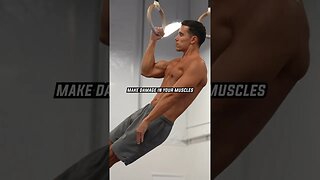Premium Only Content

Gymnast Routine for BIGGER DELTS
Get the shredded physique of a gymnast! Download the app, become a member and get full access:
Google Play Store: https://play.google.com/store/apps/details?id=com.virfortis.gymmethod
App Store: https://apps.apple.com/us/app/gymnastics-method/id1661126178
If you want to build bigger delts or just want to avoid shoulder injuries, the exercises shown in this video will help you with both!
You will not only have a wider look, but will be able to maintain healthy shoulders and avoid injuries.
The deltoid muscle is the most superficial shoulder muscle that consists of 3 parts:
- the anterior part, which also known as the clavicular part since it origins on the claivcle bone
- the lateral part, which also known as the acromial part, since it origins on the acromion
- and the posterior part, or spinal part which origins on the spine of the scapula.
All three parts insert on the humerus and move it the following ways:
- the anterior part performs flexion and internal rotation in the shoulder joint,
- the lateral part is responsible of the abduction of the arm at the shoulder joint,
- and the posterior part assists in the extension and external rotation of the arm at the shoulder join.
In the internal and external rotation the rotator cuff also has a key role, strengthening those muscles is crucial to have healthy shoulders and to be able to perform several exercises.
I’ve already talked the strengthening of the rotator cuff in my pervious videos, but due to the overlap resulting from the muscle functions, it will also be involved in some of these exercises.
Since the deltoid is a superficial muscle by strengthening it, you can really add to your physique, just take a look at a ring specialist gymnast. Besides the brutal biceps, the delts will be the other really spectacular muscles.
You can improve your delts with numeous pushing and pulling exercises. You can work on the anterior part with a simple push up, throught the dips to the iconic handstand push ups.
The posterior part will be under load in several pulling exercises if you do them right, this is why I’m emphasizing the importance of full range of motion. If you can do decent inverted rows and chest to bar pullups, your rear delts will get a good stimulus, as your elbows move behind your body.
In certain exercises such as the ring face pull or scapula swing, the lateral part also takes its part, but specific targeting of the side delts is pretty difficult with compound exercises, so the best if you do some isolations, which I’ll show you in this routine.
You should do this routine with a low intensity elastic band, which will provide the opportunity to do it as part of your prehab routine, but will also be intensive enough to do it as a shoulder workout.
Like I said, you can load your delts really well with the compound exercises I’ve mentioned, then you can give an extra push.
And now, let’s see the routine in order of the different parts and actions of the muscle!
-
 0:44
0:44
GymnasticsMethod
1 year ago $0.01 earnedIdeal Training:Rest Ratio
98 -
 50:18
50:18
Ben Shapiro
2 hours agoEp. 2108 - Musk, Trump Team Up To KILL Pork Bill
34.6K18 -
 1:52:02
1:52:02
vivafrei
6 hours agoLock Liz Cheney Up! Spending Bill MADNESS! Not Just Pork, but GAIN OF FUNCTION! & MORE! Viva Frei
48.8K10 -
 55:51
55:51
The Dan Bongino Show
5 hours agoWe Are NOT Falling For This Again (Ep. 2391) - 12/19/2024
673K2.7K -
 1:57:58
1:57:58
The Charlie Kirk Show
2 hours agoAmericaFest: Day 1 | Bannon, Maloney, Posobiec, O'Keefe | 12.19.24
84.9K4 -
 50:08
50:08
TheAlecLaceShow
4 hours agoGuests: AG Andrew Bailey & Dr. Michael Schwartz | DOGE Shuts Down Speaker’s CR | The Alec Lace Show
25.8K1 -
 LIVE
LIVE
hambinooo
2 hours agoPUBG DOMINATION
64 watching -
 1:03:06
1:03:06
The Rubin Report
4 hours ago‘Piers Morgan’ Goes Off the Rails as 'TYT' Host Attacks Dave with Nasty Insults
60.9K81 -
 1:47:50
1:47:50
Steven Crowder
4 hours agoLWC Christmas Special 2024 | Giving Back with Santa Crowder
143K422 -
 LIVE
LIVE
The Dana Show with Dana Loesch
2 hours agoTRUMP SLAMS SPENDING DEAL | The Dana Show LIVE On Rumble!
648 watching